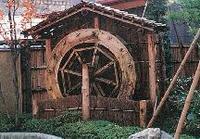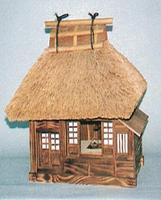

Total:131items
- Pottery & Porcelain (18)
- Lacquerware (4)
- Glasswork (2)
- Wood & Bamboo Work (19)
- Leather Work (1)
- Papermaking (13)
- Textile (20)
- Dyeing products (5)
- Masonry (1)
- Metal Work (11)
- Stationery (4)
- Livingware (3)
- Accessory (4)
- Toys & Entertainment (14)
- Interior (2)
- Other crafts (10)
- Osaka Shamisen (Japanese three-stringed guitar)
- Kyo-Hanga: Kyoto woodblock print
- Hyuga Kendo Armor
- Kanazawa-Haku: Kanazawa Gold Leaf
- Simotsuke-Suisha: Simotsuke Waterwheel
- Koshigaya-Katchu: Japanese traditional armor
- Ise netsuke : Ise miniature wooden sculpture
- Yuton: Lacquered Paper Mat
- Iwami Kagura Mask
- Oroku-gushi: Oroku-gushi Combs

 |
Main Production Site:Tochigi |
 《Characteristics》
《Characteristics》Simotsuke-suisha has developed in a mountainous area with rapid stream. It is not only practical but beautiful featuring its Sokuita (Side board), which is formed with two kinds of boards, Makuita (Flashing board) and Tsugiita (Joined board). It has been continuously improved to resist water power by reinforcing arch-shaped Makuita with Tsugiita.
The position of water pouring to turn a wheel decides how it is called. The top position is called Uwagake, the middle position is called Munegake, and the bottom position is called Shitageke. Each waterwheel has its own characteristics. As water only flows on wings, for Uwagake position, L-shaped gutter is equipped behind the body of waterwheel and its direction is adjusted to gather water there to make the waterwheel run by the power.
Nowadays, indeed a small number of waterwheels are used for practical purposes including obtaining ingredient of incense, but demand for waterwheel is mainly for a decorative purpose. It helps create pleasance in a garden, a shop or a park by adding its unique charm and bringing nostalgia. Today, Shimotsuke-mini suisha (a miniature Shimotsuke waterwheel) for interior decoration is also made with its inherited traditional technique.
[Traditional Craft Designated by Tochigi Prefecture]
Provided by Akikazu Fujihira
Translated by: Hiromi Fujii, reviewed by Marina Izumi

| Materials | Pine (Wing), Zelkova (Core) |
|---|---|
| Crafting Processes | Each part is made separately before putting them together.
[1] Prepare for making Factors including a place of installation, the volume of water, the difference of elevation, and the size of a waterwheel are decided through examination. [2] Make parts of the wheel Sokuita (Makuita and Tsugiita), Waita (Waterwheel body board), Haneita (Wing board) and Kumote (Stick board) are made. [3] Design and make a gear wheel Gear wheel is made, after the size and engine speed are decided according to its installation purpose and usage. |
| History | Despite its decline of tradition, the traditional technique and style were revived by Katsuuji Fujihira in Showa period (20c).
Katsuuji Fujihira was born and grew up in Kanuma, Tochigi Pref., a city famous for wood industry. After trained at a local store specializing in decorative timber, he started his own business of producing decorative timer in 1952. As precious woods are required for Sukiya-zukuri, a Japanese residential architectural style, old material of waterwheel came to be used as a decorating board for this style or a part of waterwheel came to be used as interior goods. Having interests in waterwheel, Fujihira realized the excellence of the structure of waterwheels in Tochigi through his journey to explore waterwheels in various regions. He thought of restoring waterwheels, but lots of waterwheel craftsmen had already gone. This prompted him to create waterwheels himself for the revival of Shimotsuke-suisha. |
◆Exhibition / Showcase
Kinofurusato traditional craft center
1556-1 Asau-chou Kanuma city,
Tochigi prefecture, 322-0058
Telephone: +81(0)289-64-6131 (Japanese only)
Opening Hours: 9:00am - 5:00pm
Closed: Tuesday, Next day to national holiday, Yearend and New Year's holiday
Assistance needed? For inquiries in English:
JTCO Contact Form
Your inquiries will be forwarded by JTCO in Japanese to the organization you wish to contact.
*Please write the name of craft you wish to ask about.



